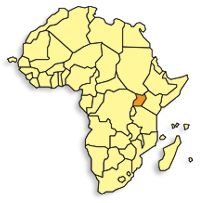It was heart wrenching at times reading about the horrible ways that innocent people were slaughtered by machetes, clubbed to death or tortured. One of the most moving parts of the exhibit was a picture memorial – which displayed thousands of victims photos (everything from polaroids, school pictures, to wedding photos). Vicki and I spent quite a lot time just looking at all the people. I think I spoke to this in an earlier post about HIV, and how I find statistics dehumanizing at times. For me, seeing people’s photos, allowed me to imagine what the person may have been like, their stories, their family, etc. which makes everything so much more real. There were also some smaller rooms which displayed victim’s bloodstained clothes, some personal belongings, identity cards, and skulls and bones - which was equally haunting.
Upstairs they had two smaller exhibits – one on other genocides that have happened around the world (Armenia, Holocaust, Cambodia, Namibia, among others). At the end of the exhibit there was a quote I find appropriate:
“If you must remember, remember this…
The Nazis did not kill six million Jews,
Nor did the Interhamwe kill a million Tutsis.
They killed one and then another, then another…
Genocide is not a single act of murder,
It is a million acts of murder”
The last exhibit – which I found the hardest was called something like “Lives Wasted” or “Wasted Opportunities”, something to that affect. It featured probably fifteen or twenty kids. Each one had a large blown up picture of them, and then a plaque that had there name, age, favorite foods, favorite games, best friend, what they wanted to be when they grew up, and then how they died (things that were absolutely unimaginable to me – machete to the head, thrown against a wall, tortured to death). I had a bit of a breakdown, walking around reading these things. Both very moving and very touching.

Outside the main building, are 11 mass graves where the remains of about 250,000 people lie. I found it hard to imagine, that’s more than double the population of Thunder Bay. I had trouble wrapping my head around the fact that the genocide happened in Rwanda – as it now seems so peaceful, and its such a stunningly beautiful country. I couldn’t help but wonder when I talked with people around town what they must have been going through less than fifteen years ago.
"We will never forget you" on one of the mass graves.


Next we went to Hotel des Milles Collines (Hotel Rwanda), which is quite the posh hotel. We went down by the pool and sat at a table by the bar and just had a drink and chatted for a little while. You would have never known it was a huge refuge for so many during the genocide had you not seen the movie or read about it (there were no plaques, or signs, just a regular nice hotel). Knowing the history was kind of chilling to sit there… When I got back to Jinja, I read the autobiography of Paul Rusesabagina, the manager of the hotel at the time, entitled “An Ordinary Man”. I highly recommend it if you’re at all interested in learning more about the genocide and about the hotel. It’s written quite simply and reads MUCH more easily than “Shake Hands with the Devil” (Romeo Dallaire), which I read a couple years ago, and found it difficult to follow because it was from such a military perspective.



No comments:
Post a Comment